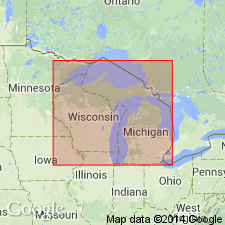
- Usage in publication:
-
- Anvil ferruginous chert member
- Modifications:
-
- Original reference
- Dominant lithology:
-
- Ferruginous chert
- AAPG geologic province:
-
- Lake Superior region
- Wisconsin arch
Summary:
Pg. 501, 505. Anvil ferruginous chert member, top member of Ironwood formation. Dominantly wavy-bedded granular or fine-grained ferruginous cherts, 0 to 375 feet thick. Eroded away in places. Overlies Fence ferruginous slate member. Age is Precambrian (upper Huronian).
Named from Anvil Mine east of Bessemer, Gogebic Co., Northern Peninsula, northwestern MI.
Source: Modified from US geologic names lexicon (USGS Bull. 896, p. 59).
- Usage in publication:
-
- Anvil Member*
- Modifications:
-
- Redefined
- Age modified
- AAPG geologic province:
-
- Wisconsin arch
Schmidt, R.G., and Hubbard, H.A., 1972, Penokean orogeny in the central and western Gogebic region, Michigan and Wisconsin: [unknown]
Summary:
Anvil Member of Ironwood Iron-Formation of Menominee Group. Present in northwestern Michigan and northern Wisconsin. Name changed from Anvil Ferruginous Chert Member to Anvil Member. Age changed from middle Precambrian --to-- Precambrian X.
Source: Changes in stratigraphic nomenclature, 1978 (USGS Bull. 1482-A, p. A2-A3).
For more information, please contact Nancy Stamm, Geologic Names Committee Secretary.
Asterisk (*) indicates published by U.S. Geological Survey authors.
"No current usage" (†) implies that a name has been abandoned or has fallen into disuse. Former usage and, if known, replacement name given in parentheses ( ).
Slash (/) indicates name conflicts with nomenclatural guidelines (CSN, 1933; ACSN, 1961, 1970; NACSN, 1983, 2005, 2021). May be explained within brackets ([ ]).

